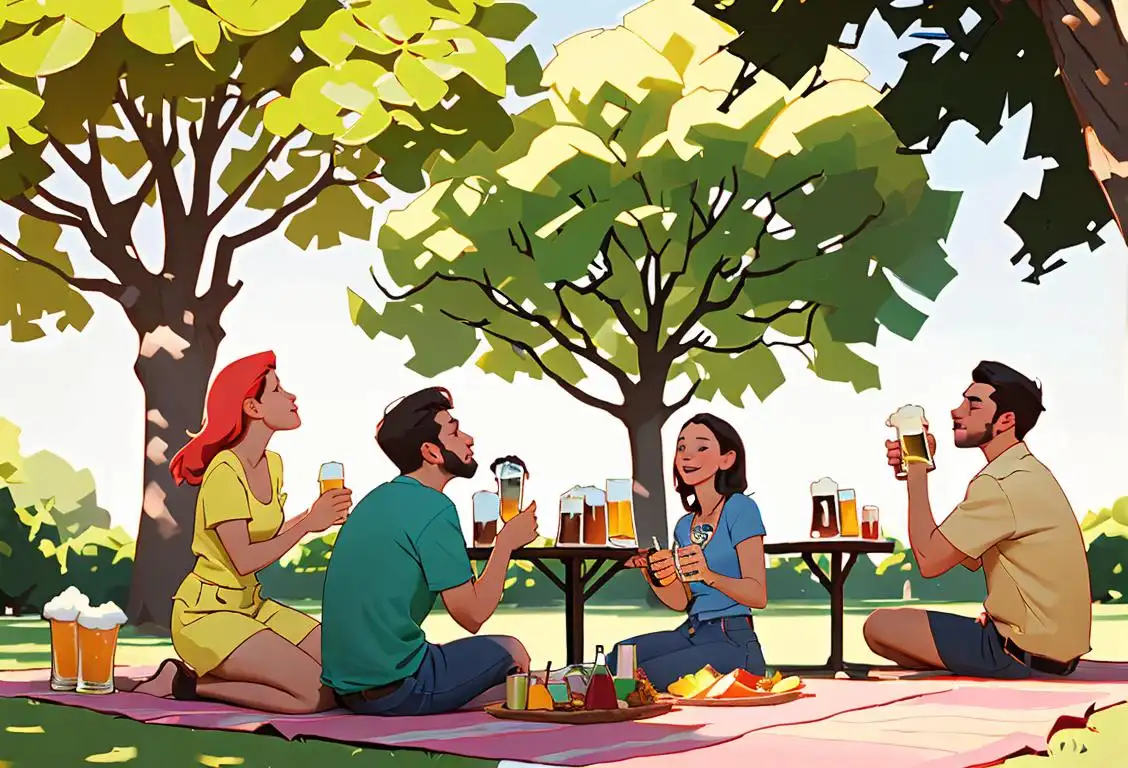National Drink Coffee Day

Hey coffee lovers! Get ready to celebrate your favorite bittersweet beverage on National Drink Coffee Day! This delightful holiday is all about raising a cup of java and reveling in its aromatic goodness. So grab your favorite mug, settle in, and let's dive into the rich history and delightful facts about this caffeinated festivities.
When is Drink Coffee Day?
It's national drink coffee day on the 29th September.
A Brief History of National Drink Coffee Day
Did you know that National Drink Coffee Day was first celebrated online? Yes, this caffeine-fueled phenomenon began in the virtual world, where coffee addicts banded together to proclaim their love for the brown elixir of life.
Back in 2016, on September 29th, the internet exploded with coffee-related content, with over 30 mentions of the celebration. It was a testament to the unwavering devotion people have for coffee, and it quickly became a beloved occasion.
Coffee: More Than Just a Drink
Coffee isn't just a beverage; it's a way of life. From cozy coffee shops to bustling cafés, this sacred nectar has created a vibrant and passionate community. It brings people together, fuels conversations, and ignites creativity. Whether you prefer a classic blend, a frothy latte, or a bold cold brew, coffee is a universal language that bridges gaps and sparks connections.
The history of coffee dates back centuries. Legend has it that an Ethiopian goat herder discovered coffee when he noticed his flock becoming unusually energetic after eating the cherries from a certain bush. Intrigued, he tried the cherries himself and experienced a similar burst of energy. And thus, the magical world of coffee was born.
A Fun Fact for Your Java Journey
Did you know that coffee is actually a fruit? Yes, those beautiful, vibrant coffee cherries are technically berries. They grow on trees and are hand-picked when they reach the perfect ripeness. Each little bean we savor is the seed found inside these cherries. Mind-blowing, right?
So, the next time you sip your morning cup of joe, take a moment to appreciate the journey those humble coffee beans have made from tree to mug.
Celebrate National Drink Coffee Day with Love and Laughter
On National Drink Coffee Day, show your love and appreciation for your favorite brew. Share a cup of joe with your loved ones, indulge in delicious coffee-flavored treats, and embrace the warmth that this magical elixir brings to your soul.
Don't forget to snap a photo of your coffee adventures and share it with the world using the hashtag #DrinkCoffeeDay. Let's connect over our shared love for this beloved beverage!
History behind the term 'Drink Coffee'
850
Discovery of coffee beans
In the year 850, in the highlands of present-day Ethiopia, a goat herder named Kaldi stumbled upon a peculiar sight. His goats had consumed red berries from a specific tree and were unusually energetic. Curiosity led Kaldi to try these berries himself, resulting in increased alertness and a burst of energy. This marked the accidental discovery of coffee beans.
1475
Discovery of Coffee
Coffee was first discovered in Ethiopia by a goat herder named Kaldi. Legend has it that Kaldi noticed his goats becoming energetic after eating the berries from a certain tree. Intrigued, he decided to try the berries himself and experienced a similar rejuvenating effect. News of this newfound energy-boosting fruit spread throughout the region.
1475
The Discovery of Coffee
In 1475, coffee was discovered in Ethiopia by a goat herder named Kaldi. Legend has it that Kaldi noticed his goats became more energetic and lively after eating the berries from a certain shrub. Intrigued, he tried the berries himself and experienced a similar energizing effect. This led to the discovery and cultivation of coffee plants in the region.
1475
Discovery of Coffee Beans
Coffee beans were discovered in Ethiopia by a goatherd named Kaldi. According to a popular legend, Kaldi noticed that his goats became energized and restless after consuming certain berries from a particular tree. Intrigued, Kaldi sampled the berries himself and experienced a similar burst of energy. This discovery laid the foundation for the future use of coffee as a stimulating beverage.
15th Century
Early Coffee Consumption in the Arabian Peninsula
During the 15th century, the consumption of coffee began to spread throughout the Arabian Peninsula. The Sufi monks in Yemen recognized the stimulating properties of coffee and incorporated it into their religious rituals. The monks found that coffee helped them stay awake and focused during long periods of prayer and meditation. This early adoption of coffee played a significant role in the establishment of the first coffeehouses.
1511
Introduction of Coffee to the Arab World
Coffee made its way to the Arab world when the governor of Yemen, Khair Beg, brought some coffee beans from his homeland Ethiopia. He planted the beans in Yemen, where they flourished due to the favorable climate. Coffee became a popular drink among the Arabs, and they even developed a method of brewing it using boiling water, creating a precursor to the modern-day coffee preparation process.
1475-16th century
Coffee's Journey to Arabia
Coffee soon made its way from Ethiopia to the Arabian Peninsula, where it was cultivated and traded. It gained popularity for its stimulating effects and became an integral part of the Arab culture. It was commonly consumed in the form of a hot beverage, which was prepared by roasting and grinding the coffee beans.
1475
Introduction of coffee to Constantinople
Jumping ahead to 1475, coffee was introduced to the city of Constantinople (now Istanbul) in the Ottoman Empire. The city quickly became captivated by the stimulating effects of coffee. This led to the establishment of the first coffeehouses, known as kahvehane, where people gathered to drink coffee, socialize, and engage in intellectual discussions.
1475-17th Century
Coffeehouses and Social Gathering Places
By the late 15th century, coffeehouses began to emerge in the Arabian Peninsula. These establishments quickly became social gathering places where people could relax, socialize, and discuss various matters. Coffeehouses were known as 'qahveh khaneh' or 'qahwa' in Arabic, which translates to 'coffee houses.' It is believed that coffeehouses played a crucial role in the exchange of knowledge, ideas, and cultural developments.
1615
Opening of the first European coffeehouse
In 1615, the first European coffeehouse, known as the Kiva Han, opened its doors in Venice, Italy. Coffee quickly gained popularity, attracting a diverse clientele. The concept of coffeehouses spread rapidly across Europe, creating social hubs for people from various walks of life to come together and enjoy this new beverage.
16th century
Introduction to Europe
Coffee made its way to Europe through trade routes, primarily thanks to Venetian and Ottoman traders. The first European coffee house opened in Venice in 1645, which sparked a coffee craze across the continent. People flocked to coffee houses as vibrant social hubs, where intellectuals gathered to discuss literature, philosophy, and politics while enjoying a cup of the aromatic beverage.
1615
Spread of Coffee to Europe
Coffee was introduced to Europe when Venetian merchants came across it during their trade missions to the Middle East. Initially, coffee was seen as a beverage with medical and exotic properties. It gained popularity in Venice and soon spread to other major European cities, including London, Paris, and Amsterdam. The first European coffeehouse, Kiva Han, was opened in Constantinople in the early 16th century and paved the way for the coffeehouse culture that swept across Europe.
1674
Introduction of coffee to North America
The year 1674 witnessed the arrival of coffee in North America. The first coffeehouse, called the King's Arms, opened in New York City. The establishment became a popular meeting place for sailors, merchants, and philosophers. Coffee's grip on American society steadily grew, eventually leading to the creation of iconic national coffee brands.
17th Century
Introduction of Coffeehouses to Europe
Coffeehouses were introduced to Europe during the 17th century. The first European coffeehouse opened its doors in Venice, Italy, in 1645. From there, coffeehouses spread rapidly throughout Europe, becoming popular meeting places for intellectuals, artists, and merchants. These establishments were often referred to as 'penny universities' because for the price of a cup of coffee, patrons could engage in stimulating conversations and debates with like-minded individuals.
17th-18th century
Colonial Expansion and Worldwide Spread
During the colonial period, major European powers established coffee plantations in their colonies. This led to the widespread cultivation of coffee in regions such as South America, the Caribbean, and Africa. Coffee soon became a global commodity, with different regions having their own unique methods of preparing and consuming it.
1727
Introduction of Coffee to the Americas
Coffee arrived in the Americas through French naval officer Gabriel de Clieu. He acquired a coffee plant from the Jardin des Plantes in Paris and successfully transported it to the Caribbean island of Martinique. There, the coffee plant thrived in the tropical climate and became the foundation for the coffee industry in the Americas. Coffee cultivation quickly spread throughout the Caribbean islands and later expanded to Central and South America, making the region one of the largest coffee producers in the world.
1901
Birth of Instant Coffee
In 1901, Japanese scientist Satori Kato invented instant coffee by experimenting with dry coffee extract. Kato's discovery revolutionized the coffee industry, as it allowed for easy and quick preparation of coffee without the need for brewing equipment. Instant coffee gained popularity during World War II when it became a staple for soldiers due to its convenience and long shelf life. Today, instant coffee remains a popular choice for many who seek a quick caffeine fix.
20th century
Industrialization and Coffee Culture
The 20th century brought advancements in coffee production, such as the invention of instant coffee and the development of coffee filters. This made coffee more accessible to the masses. Coffee culture thrived, and coffee became an integral part of people's daily routines. Coffee shops became trendy gathering places for socializing, conducting business meetings, or enjoying a moment of solitude with a cup of coffee.
18th Century
Coffee's Influence on Enlightenment Era
During the 18th century, coffee played a significant role in the Enlightenment era. Coffeehouses became hotspots for intellectual discussions, fueled by the stimulating effects of the beverage. Thinkers, philosophers, and writers frequented coffeehouses to exchange ideas and engage in debates. Some of the notable figures associated with coffeehouse culture during this period include Voltaire, Rousseau, and Benjamin Franklin. Coffee became synonymous with the intellectual and enlightened mind.
1901
Invention of instant coffee
Fast-forwarding to 1901, a Japanese chemist named Satori Kato invented instant coffee. This groundbreaking innovation revolutionized the way coffee was prepared and consumed, providing a convenient and accessible option for coffee lovers worldwide. Instant coffee's popularity soared during World War II as it became a staple in military rations.
1990
Third wave coffee movement
In the 1990s, a movement known as the 'third wave' of coffee emerged. It focused on the idea of coffee as an artisanal, gourmet beverage. Third wave coffee enthusiasts emphasized the quality of beans, transparency of sourcing, unique brewing methods, and appreciation for the complexities of flavor, connecting consumers to the origins and culture surrounding coffee.
19th Century
Industrialization and Coffee's Globalization
The 19th century marked a significant shift in the production and consumption of coffee. Industrialization revolutionized coffee production, making it more accessible and affordable to a larger population. As coffee plantations expanded in various parts of the world, demand soared. Coffee became a global commodity, with new brewing methods and specialized coffee equipment advancing the coffee culture. The beverage became increasingly ingrained in people's daily lives around the world.
21st century
Coffee Revolution and Specialty Coffee
The 21st century witnessed a coffee revolution with a significant focus on specialty coffee. Coffee enthusiasts began to appreciate the unique flavors and characteristics of different coffee beans, leading to the rise of artisanal coffee shops and specialty coffee roasters. The demand for high-quality, ethically-sourced coffee grew, promoting sustainability and fair trade practices within the coffee industry.
20th Century
Coffee Chains and Specialty Coffee
In the 20th century, coffee experienced further transformations. Coffee chains like Starbucks emerged, bringing the coffeehouse culture to mainstream society. More emphasis was placed on the quality and specialty of coffee. The rise of specialty coffee introduced a new wave of coffee connoisseurs, focusing on high-quality beans, precise brewing methods, and unique flavor profiles. The coffee industry had evolved into a multifaceted global phenomenon.
Present
Coffee's Ubiquitous Presence
Today, coffee has become a staple in many people's lives. It is estimated that over 2.25 billion cups of coffee are consumed daily worldwide. Coffee-drinking has evolved into a ritual, whether enjoyed at home, in coffee shops, or on the go. The beverage has had a profound impact on societies, connecting people, fueling productivity, and inspiring creativity. The term 'drink coffee' has become synonymous with a vibrant coffee culture that stretches across the globe.
Did you know?
Did you know that coffee is actually a fruit?Tagged
food fun loved onesFirst identified
29th September 2015Most mentioned on
29th September 2016Total mentions
30Other days
Biscuit Day
Cheese Lovers Day
Cheese Pizza Day
Agriculture Day
Bacon Day
Medal Of Honor Day
Pumpkin Day
Foundation Day
Guac Day
Drink A Beer Day









